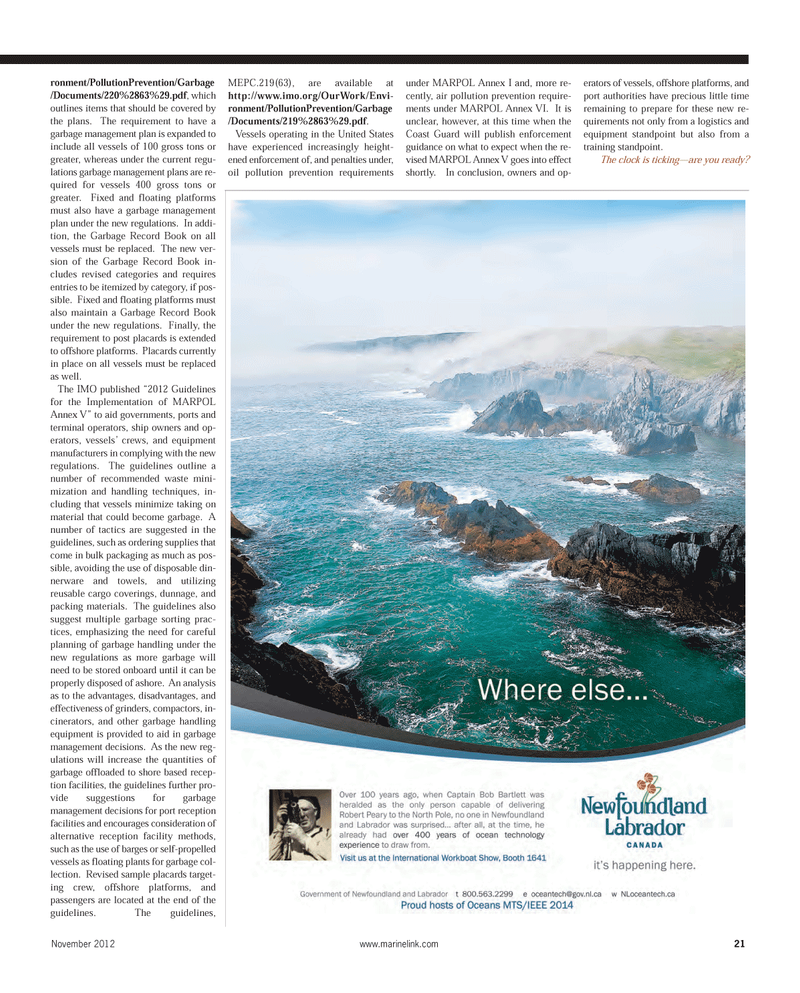
Page 21: of Maritime Reporter Magazine (November 2012)
Workboat Annual
Read this page in Pdf, Flash or Html5 edition of November 2012 Maritime Reporter Magazine
November 2012www.marinelink.com 21ronment/PollutionPrevention/Garbage /Documents/220%2863%29.pdf, whichoutlines items that should be covered by the plans. The requirement to have a garbage management plan is expanded to include all vessels of 100 gross tons or greater, whereas under the current regu- lations garbage management plans are re- quired for vessels 400 gross tons or greater. Fixed and floating platforms must also have a garbage management plan under the new regulations. In addi- tion, the Garbage Record Book on allvessels must be replaced. The new ver- sion of the Garbage Record Book in-cludes revised categories and requires entries to be itemized by category, if pos- sible. Fixed and floating platforms must also maintain a Garbage Record Bookunder the new regulations. Finally, the requirement to post placards is extended to offshore platforms. Placards currently in place on all vessels must be replaced as well. The IMO published ?2012 Guidelinesfor the Implementation of MARPOLAnnex V? to aid governments, ports and terminal operators, ship owners and op- erators, vessels? crews, and equipment manufacturers in complying with the new regulations. The guidelines outline a number of recommended waste mini- mization and handling techniques, in-cluding that vessels minimize taking on material that could become garbage. A number of tactics are suggested in theguidelines, such as ordering supplies thatcome in bulk packaging as much as pos- sible, avoiding the use of disposable din- nerware and towels, and utilizing reusable cargo coverings, dunnage, and packing materials. The guidelines also suggest multiple garbage sorting prac- tices, emphasizing the need for carefulplanning of garbage handling under the new regulations as more garbage will need to be stored onboard until it can beproperly disposed of ashore. An analysis as to the advantages, disadvantages, and effectiveness of grinders, compactors, in- cinerators, and other garbage handling equipment is provided to aid in garbage management decisions. As the new reg- ulations will increase the quantities ofgarbage offloaded to shore based recep- tion facilities, the guidelines further pro- vide suggestions for garbage management decisions for port receptionfacilities and encourages consideration of alternative reception facility methods, such as the use of barges or self-propelled vessels as floating plants for garbage col- lection. Revised sample placards target- ing crew, offshore platforms, and passengers are located at the end of theguidelines. The guidelines, MEPC.219(63), are available at http://www.imo.org/OurWork/Envi- ronment/PollutionPrevention/Garbage /Documents/219%2863%29.pdf. Vessels operating in the United States have experienced increasingly height- ened enforcement of, and penalties under, oil pollution prevention requirements under MARPOL Annex I and, more re- cently, air pollution prevention require- ments under MARPOL Annex VI. It is unclear, however, at this time when the Coast Guard will publish enforcementguidance on what to expect when the re- vised MARPOL Annex V goes into effect shortly. In conclusion, owners and op- erators of vessels, offshore platforms, and port authorities have precious little time remaining to prepare for these new re- quirements not only from a logistics andequipment standpoint but also from a training standpoint. The clock is ticking?are you ready? MR#11 (18-25):MR Template 10/26/2012 2:27 PM Page 21

 20
20

 22
22
